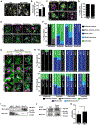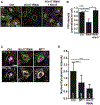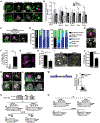Kin17 regulates proper cortical localization of Miranda in Drosophila neuroblasts by regulating Flfl expression
- PMID: 38386552
- PMCID: PMC10980573
- DOI: 10.1016/j.celrep.2024.113823
Kin17 regulates proper cortical localization of Miranda in Drosophila neuroblasts by regulating Flfl expression
Abstract
During asymmetric division of Drosophila larval neuroblasts, the fate determinant Prospero (Pros) and its adaptor Miranda (Mira) are segregated to the basal cortex through atypical protein kinase C (aPKC) phosphorylation of Mira and displacement from the apical cortex, but Mira localization after aPKC phosphorylation is not well understood. We identify Kin17, a DNA replication and repair protein, as a regulator of Mira localization during asymmetric cell division. Loss of Kin17 leads to aberrant localization of Mira and Pros to the centrosome, cytoplasm, and nucleus. We provide evidence to show that the mislocalization of Mira and Pros is likely due to reduced expression of Falafel (Flfl), a component of protein phosphatase 4 (PP4), and defects in dephosphorylation of serine-96 of Mira. Our work reveals that Mira is likely dephosphorylated by PP4 at the centrosome to ensure proper basal localization of Mira after aPKC phosphorylation and that Kin17 regulates PP4 activity by regulating Flfl expression.
Keywords: CP: Cell biology; CP: Developmental biology; Drosophila; Falafel; Kin17; Miranda; Prospero; cell polarity; neuroblast; protein phosphatase 4; splicing.
Copyright © 2024 The Author(s). Published by Elsevier Inc. All rights reserved.
Conflict of interest statement
Declaration of interests The authors declare no competing interests.
Figures







Similar articles
-
Protein phosphatase 4 mediates localization of the Miranda complex during Drosophila neuroblast asymmetric divisions.Genes Dev. 2009 Feb 1;23(3):359-72. doi: 10.1101/gad.1723609. Genes Dev. 2009. PMID: 19204120 Free PMC article.
-
Phosphotyrosyl phosphatase activator facilitates localization of Miranda through dephosphorylation in dividing neuroblasts.Development. 2016 Jan 1;143(1):35-44. doi: 10.1242/dev.127233. Epub 2015 Nov 19. Development. 2016. PMID: 26586222
-
Clueless regulates aPKC activity and promotes self-renewal cell fate in Drosophila lgl mutant larval brains.Dev Biol. 2013 Sep 15;381(2):353-64. doi: 10.1016/j.ydbio.2013.06.031. Epub 2013 Jul 5. Dev Biol. 2013. PMID: 23835532
-
Polarization of Drosophila neuroblasts during asymmetric division.Cold Spring Harb Perspect Biol. 2009 Aug;1(2):a001388. doi: 10.1101/cshperspect.a001388. Cold Spring Harb Perspect Biol. 2009. PMID: 20066083 Free PMC article. Review.
-
Mechanisms of asymmetric progenitor divisions in the Drosophila central nervous system.Adv Exp Med Biol. 2013;786:79-102. doi: 10.1007/978-94-007-6621-1_6. Adv Exp Med Biol. 2013. PMID: 23696353 Review.
Cited by
-
Kin17 promotes rDNA transcription, ribosomal biogenesis, and cortical lamination.EMBO Rep. 2025 Jul 17. doi: 10.1038/s44319-025-00524-3. Online ahead of print. EMBO Rep. 2025. PMID: 40676207
References
Publication types
MeSH terms
Substances
Grants and funding
LinkOut - more resources
Full Text Sources
Molecular Biology Databases
Miscellaneous

